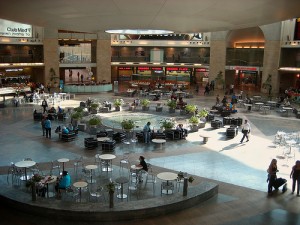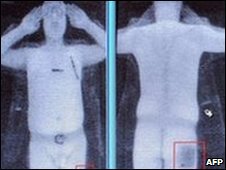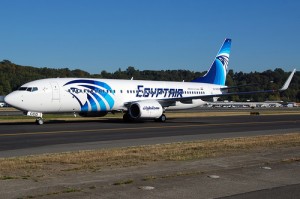
Ben Gurion International Airport outside of Tel Aviv.
A few weeks ago I wrote a blog calling body scanners a “joke” and I was quite harsh on the Transportation Security Administration’s (TSA) decision to move forward with them.
Don’t get me wrong. I fly a lot. I like my life. I am all about protecting it and those who fly with me. But, I am not about the TSA wasting money for “security theater.”
After I posted my thoughts, the TSA posted a blog titled, “Advanced Imaging Technology – Yes, It’s Worth It.” It seem to be a rebuttal to those of us who have voiced concern about the TSA moving forward with the body scanners. However, TSA’s explanation is short on actual specifics of how the body scanners will stop someone from doing harm to airlines and passengers.
In my previous blog, my biggest issue was people could choose to avoid the scanners. If you didn’t want to be scanned, you could opt to get a pat down. For privacy reasons, it is great they offer this alternative, but for safety reasons it makes no sense. Why use all this pricey equipment, if someone who wants to do harm can just avoid it?
Their blog does a wonderful job explaining how these high-tech body scanners can pick up the smallest illegal items, but nothing about how scanners can be avoided or steps that are being taken to stop more privacy violations. I posted the question directly to the folks at TSA Blog, but never got a response, even though they did answer other people’s questions.
Over on my Seattle PI syndication I currently have 45 comments from readers who feel strongly (on both sides) about the body scanners. This shows me there are quite a few other people out there that have grave concerns about these scanners. I have been told a few times, “okay smart guy, how about stop just complaining and provide a solution” (okay, maybe not exactly like that, but you get the idea).
I would really hope someone out there with experience in air safety, could find a better solution. Talking to people about airport security I kept being told to check out out how Israel works their airport and airline security. So, I did and what I found looks like they might be on to something.
Isreal’s security allows for greater security, but less inconvience for travellers. And it must work. Tel Aviv’s Ben Gurion Airport, Israel’s larget hub, has not had a security breach since 2002.
“It is mindboggling for us Israelis to look at what happens in North America, because we went through this 50 years ago,” said Rafi Sela, the president of AR Challenges, a global transportation security consultancy, in an interview with TheStar.com. He’s worked with the RCMP, the U.S. Navy Seals and airports around the world. “Israelis, unlike Canadians and Americans, don’t take shit from anybody. When the security agency in Israel (the ISA) started to tighten security and we had to wait in line for not for hours but 30 or 40 minutes, all hell broke loose here. We said, ‘We’re not going to do this. You’re going to find a way that will take care of security without touching the efficiency of the airport.”
Their security is a multi-layer system:
LAYER 0: Intelligence
Before anyone even leaves for the airport, Isreal has strong intelligence network, trying to determine particular threats and dispose of them before they even reach the first layer.
LAYER 1: Roadside Check
Before you can even get to the airport, security stops every car and asks two questions, “How are you? Where are you coming from?” The answers aren’t nearly important, but more of how the person responds. Security officers are trained to detect nervousness and distress. Not the amount that a lot of people feel from flying, but those that occur when you are about ready to kill yourself and many others.
LAYER 2: Outside Guards
Armed guards are stationed outside the terminal and are trained to observe passengers. Any sort of odd behavior or strange baggage, you will be pulled aside for additional questioning and possible searches.
LAYER 3: Bag Inspections
Passengers that look suspicious or are just random will be pulled aside to be scanned by a metal detector and have their bags scanned.
LAYER 4: Ticket Agent Questions
Now, you have fully made it into the terminal. The ticket agent will take your documents and ask you a series of questions, the whole time, looking directly into your eyes, “which is very embarrassing. But this is one of the ways they figure out if you are suspicious or not. It takes 20, 25 seconds,” said Sela. Again, they are specially trained to detect body language that would show the person means to do harm. Also, passengers are not allowed to group up, which would provide a group target for a terrorist.
LAYER 5: Bag Termination
Let’s say a terrorist has made it through the first four layers of security and still is able to get his bomb to the ticket agent. Every bag is screened right away. If a bomb or suspicious material is found, they do not evacuate the whole terminal, like you would see in America. Evacuation causes panic, more targets, and a huge delay. Instead, scanners have bomb boxes near by and a suspected bag is put into the box, which can contain an explosion of up to 100 kilos of plastic explosives. People within a few meters of the suspected bomb need to be cleared and the rest of the airport is able to go through its normal business. “This is a very small simple example of how we can simply stop a problem that would cripple one of your airports,” Sela said.
LAYER 6: Body and Luggage Check
You would think this is like America’s security check, but Sela says, “Here it is done completely, absolutely 180 degrees differently than it is done in North America. First, it’s fast there’s almost no line. That’s because they’re not looking for liquids, they’re not looking at your shoes. They’re not looking for everything they look for in North America. They just look at you.”
All these layers have solid security, but they also get passengers from the parking lot to their gate in less than 25 minutes. Now, that is impressive. Sela feels the TSA could move in this direction, but they are on the wrong path. “Even today with the heightened security in North America, they will check your items to death. But they will never look at you, at how you behave. They will never look into your eyes … and that’s how you figure out the bad guys from the good guys.”
Yes, this is profiling, but I think it is the good kind of profiling. Racial profiling = wrong, behavior profiling = right. Sela said, “To us, it doesn’t matter if he’s black, white, young or old. It’s just his behaviour. So what kind of privacy am I really stepping on when I’m doing this?”
Do the Israelis have a good security system? I think so, but I don’t think it could easily be used the exact same way in America. We definitely don’t do well with seeing people with large guns walking around and this system would be vulnerable to racial profiling. I do think looking at behavior profiling would be a better use of resources than spending money on machines that people can skip all together.
Sources: TheStar.com & Vancouver Sun Image: iamxande


